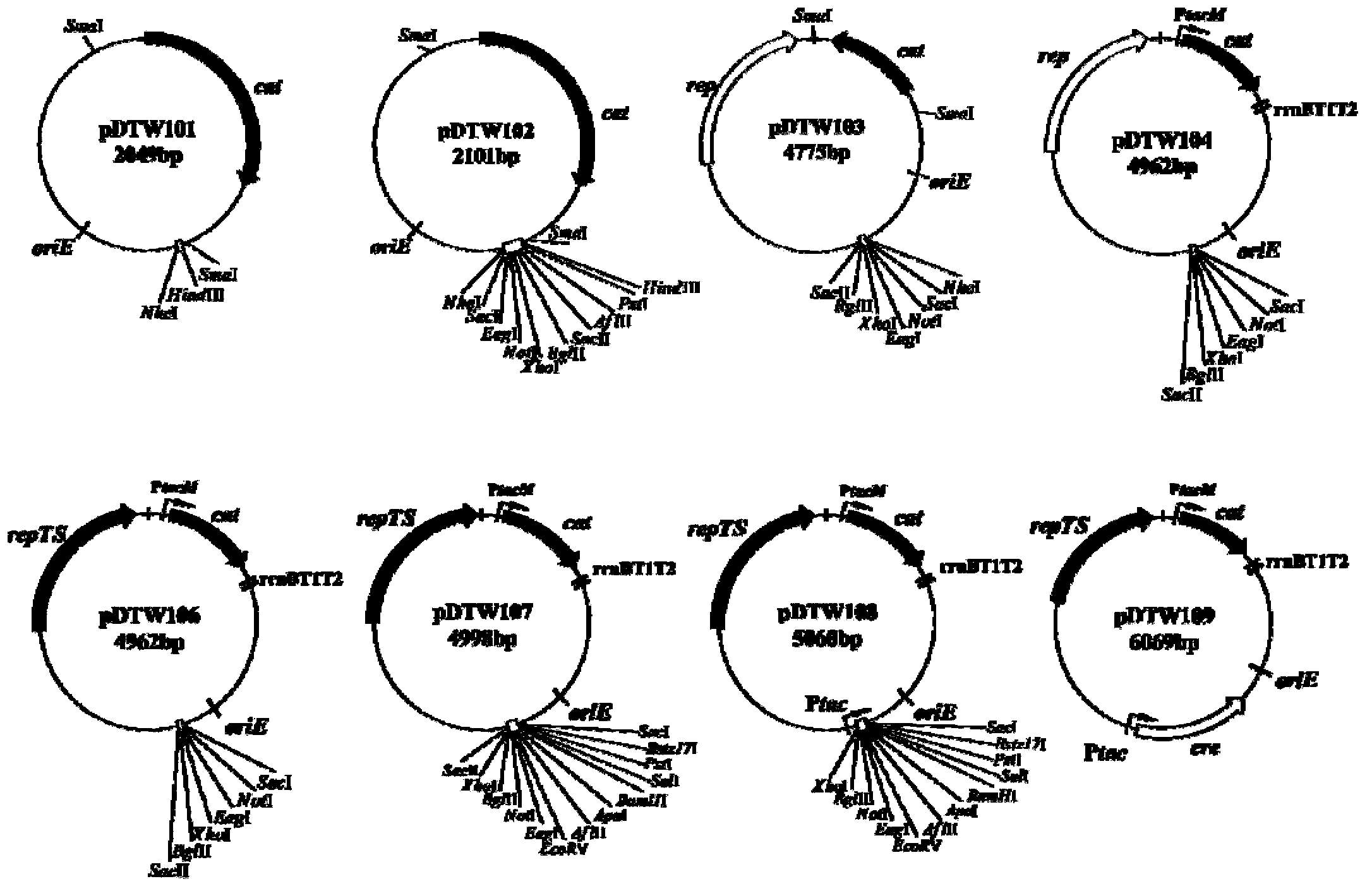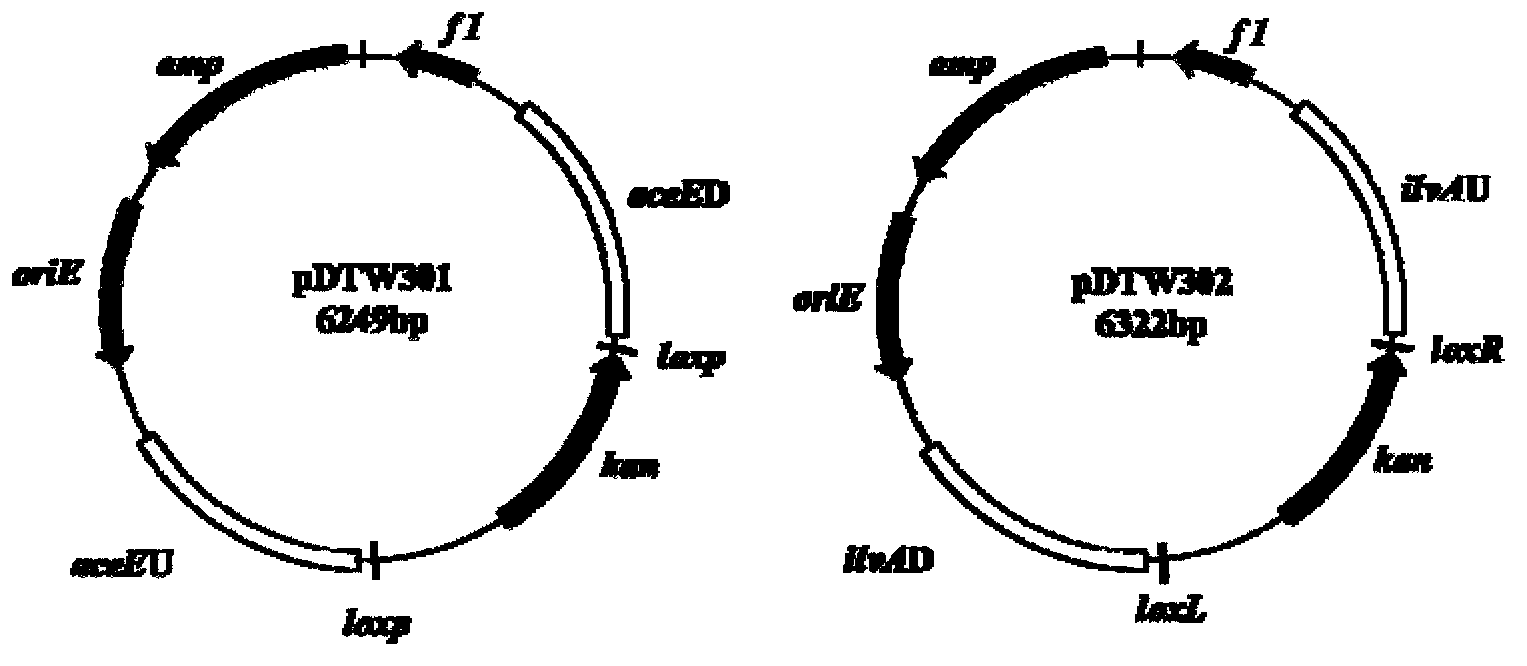Corynebacterium gene continuous knockout system, as well as construction method and application thereof
A coryneform bacterium and a construction method technology, applied in the field of microbial genetic engineering, can solve problems such as the trouble of the second round of exchange screening of sacB gene
- Summary
- Abstract
- Description
- Claims
- Application Information
AI Technical Summary
Problems solved by technology
Method used
Image
Examples
Embodiment 1
[0033] Embodiment 1 coryneform bacterium gene continuous knockout system
[0034] The coryneform bacteria gene continuous knockout system provided by the present invention includes a template plasmid and a temperature-sensitive expression plasmid; the template plasmid provides a kan fragment with loxp or mutant loxL / R sites at both ends, also known as a kan box; The sensitive expression plasmid carries the Cm resistance gene cat and the thermosensitive C. glutamicum replicon, and expresses Cre recombinase to remove the Km resistance gene kan. The template plasmid is pDTW201 / 202; the temperature-sensitive expression plasmid is pDTW109; its nucleotide sequence is shown in SEQ ID NO.1-NO.3.
[0035] The construction scheme of the coryneform bacteria gene continuous knockout system is as follows:
[0036] Step 1: Using pK18mobsacB (Schafer et al., 1994) as a template and the kan-F / kan-R primer pair as a template, PCR amplifies the kan gene, and introduces XhoI and XbaI restrictio...
Embodiment 2
[0053] Knockout of aceE in embodiment 2ATCC13032 / 14067 / 13869
[0054] 1. Obtaining the knockout plasmid pDTW301
[0055] Using the C. glutamicum ATCC14067 genome as a template, the upstream and downstream fragments of the aceE gene were amplified with corresponding primers. PstI and BamHI were introduced at the 5' and 3' ends of the upstream fragment, respectively, and XbaI and SalI restriction sites were introduced at the 5' and 3' ends of the downstream fragment, respectively. Using pDTW201 as a template, the kan box containing loxp sites at both ends was amplified with corresponding primers, and BamHI and XbaI restriction sites were introduced at the 5' and 3' ends, respectively. The upstream fragment of aceE was digested and purified with PstI and BamHI, the downstream fragment was digested and purified with XbaI and SalI, the kan box fragment was digested and purified with BamHI and XbaI, pBluescript II SK(+) was digested and purified with PstI and SalI, four fragments ...
Embodiment 3
[0071] Example 3 Knockout of ilvA in ATCC14067ΔaceE
[0072] 1. Obtaining the knockout plasmid pDTW302
[0073] Using the C. glutamicum ATCC14067 genome as a template, the upstream and downstream fragments of the ilvA gene were amplified with corresponding primers, respectively. XhoI and XbaI were introduced at the 5' and 3' ends of the upstream fragment, respectively, and PstI and BamHI restriction sites were introduced at the 5' and 3' ends of the downstream fragment, respectively. Using pDTW202 as a template, the kan box containing loxL / R sites at both ends was amplified with corresponding primers, and BamHI and XbaI restriction sites were introduced at the 5' and 3' ends, respectively. The upstream fragment of ilvA was purified by digestion with XhoI and XbaI, the downstream fragment was purified by digestion with PstI and BamHI, the kan box fragment was purified by digestion with BamHI and XbaI, pBluescript II SK(+) was purified by digestion with PstI and XhoI, four frag...
PUM
 Login to View More
Login to View More Abstract
Description
Claims
Application Information
 Login to View More
Login to View More - R&D
- Intellectual Property
- Life Sciences
- Materials
- Tech Scout
- Unparalleled Data Quality
- Higher Quality Content
- 60% Fewer Hallucinations
Browse by: Latest US Patents, China's latest patents, Technical Efficacy Thesaurus, Application Domain, Technology Topic, Popular Technical Reports.
© 2025 PatSnap. All rights reserved.Legal|Privacy policy|Modern Slavery Act Transparency Statement|Sitemap|About US| Contact US: help@patsnap.com



